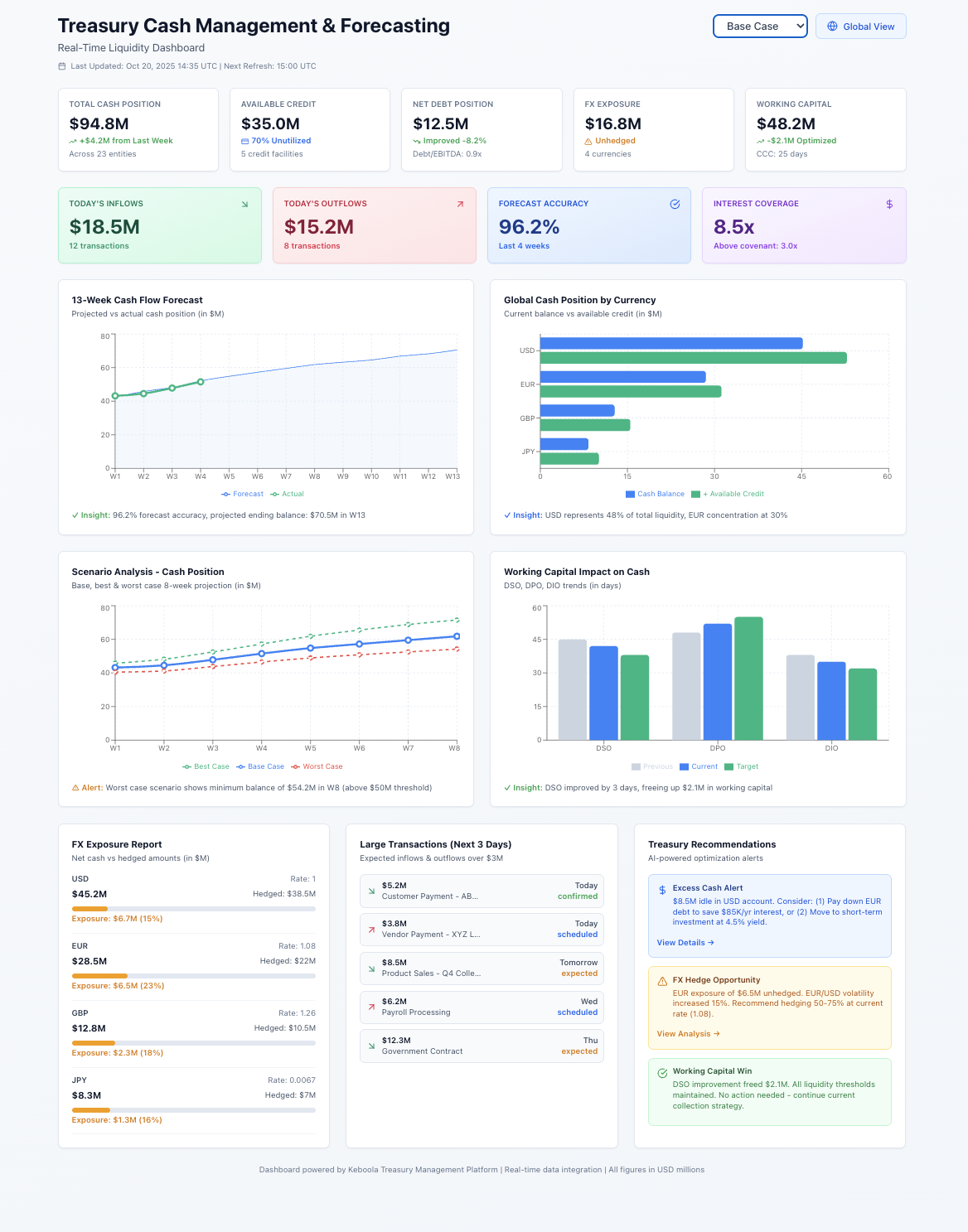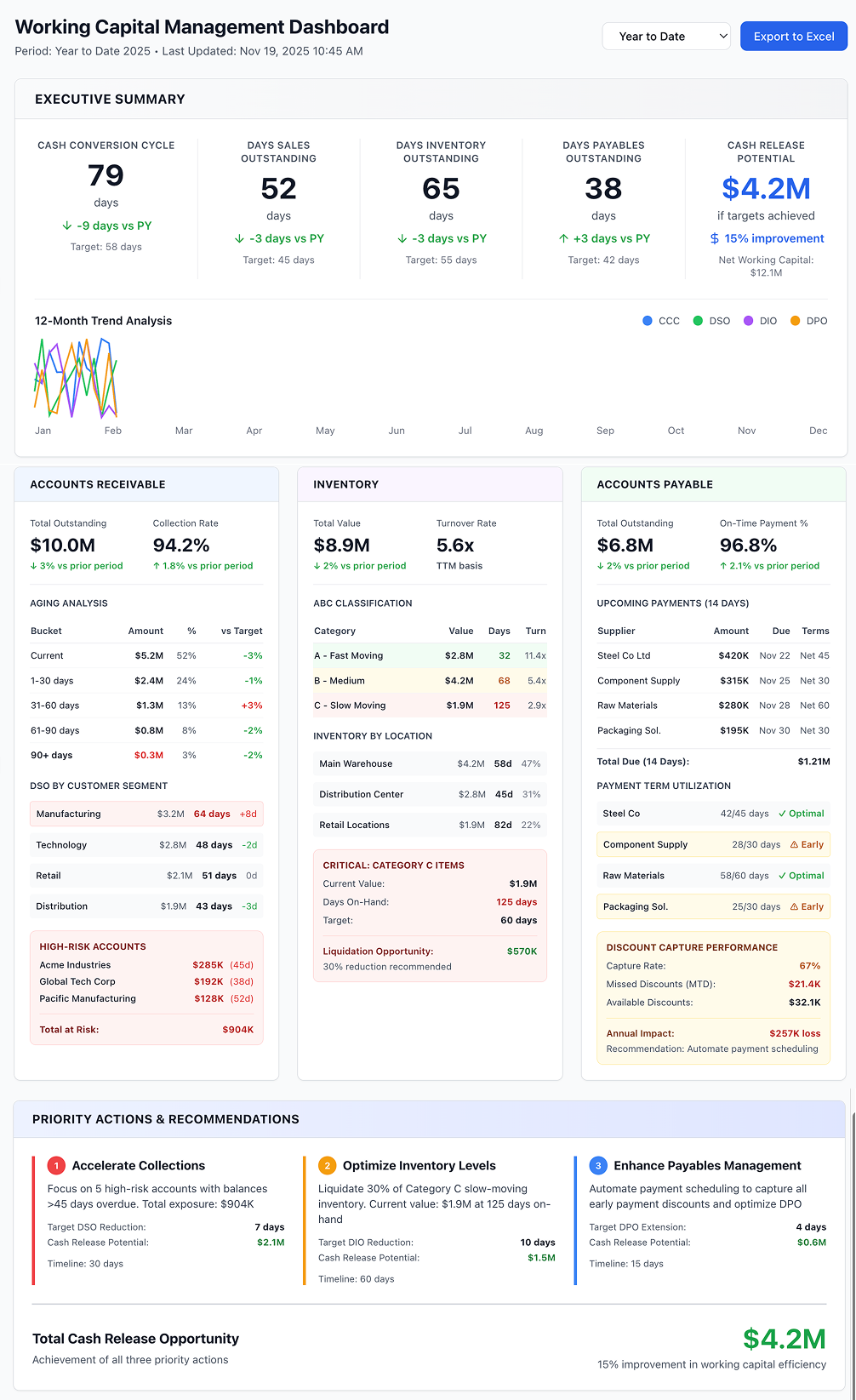Run your data operations on a single, unified platform.
- Easy setup, no data storage required
- Free forever for core features
- Simple expansion with additional credits

Thank you! Your submission has been received!
Oops! Something went wrong while submitting the form.

Request a Demo
Treasury Cash Management & Forecasting
Optimize liquidity and predict cash needs with an integrated, real-time cash flow view.

Dashboard shown is a conceptual example. Keboola integrates with any BI or analytics platform.


Overview
This use case empowers the Treasury and CFO office to manage cash across a multi-entity organization efficiently. It aggregates bank balances, cash inflows/outflows from AR/AP, and capital transactions into a single dashboard, while also automating cash flow forecasting. Mid-to-large enterprises with numerous bank accounts and currencies benefit from seeing their global cash position at a glance. The system can pull data from ERP, TMS, and even bank APIs to update balances daily.
Finance leaders can make informed decisions on funding, investments, or intercompany loans because they have an accurate picture of liquidity and near-term forecasts. A seasoned treasury professional will use this for decisions like minimizing idle cash, ensuring funding for operations, and avoiding surprises by predicting cash crunches in advance.
Your Challenges

Fragmented Cash Visibility: In many organizations, each subsidiary or department might manage its own bank accounts.

Manual Forecasting & Inaccuracies: Cash flow forecasting frequently happens in Excel silos. Operational teams send spreadsheets of expected receipts and payments, which treasury compiles.

Foreign Exchange and Interest Exposure: Without an integrated view, it’s hard to manage FX risk or interest rate exposure.

Inefficient Working Capital Use: If AR, AP, and inventory data aren’t connected to treasury, understanding working capital dynamics is challenging.


Our Solution & Value

Unified Cash Position in Real-Time
Keboola consolidates data from all bank accounts (via direct bank feeds or ERP data) and all entities into one view.

Accurate, Automated Cash Forecasts
By integrating sales forecasts, open invoices, purchase orders, payroll calendars, and other sources, the system automatically projects cash flows for the coming weeks and months.

Integrated FX and Debt Management
The use case can incorporate currency rates and debt schedules. Treasury can simulate the impact of FX rate changes on consolidated cash or identify natural hedges.

Optimized Working Capital & Liquidity Decisions
With live data on receivables, payables, and inventory flows in the platform, treasurers and CFOs can pinpoint opportunities to improve cash flow.
What systems can you connect?
Example Outputs
[stakeholder] Tresurer
- Global cash position report (by currency and entity)
- 13-week cash flow forecast
- Daily liquidity dashboard (with min/max cash thresholds alerts)
- FX exposure report
- Short-term investment and debt maturity schedule
[stakeholder] Cash Manager
- Bank account balance reconciliation
- List of large inflows/outflows today and this week
- Cash concentration sweep report
- Variance analysis of forecast vs actual cash
[stakeholder] Group CFO
- Total cash, available credit facilities, net debt position
- Working capital KPIs
- Scenario analysis showing cash impact of key what-ifs
- Compliance metrics like debt covenant ratios or interest coverage
FAQs
How does this differ from a Treasury Management System (TMS)?
Keboola isn’t a full TMS replacement – rather, it’s a data integration and analytics layer that can augment or feed a TMS. If you have a TMS, Keboola can consolidate data from the TMS, ERP, and other sources to give a more holistic view (including forecasts or non-financial drivers that TMS might not handle). If you don’t have a TMS, Keboola can provide many key functionalities (cash visibility, forecasting, basic transaction tracking) by leveraging your existing data. Essentially, it bridges gaps by unifying data and providing analytical capabilities, often at a fraction of the cost of a dedicated TMS.
How frequently are cash positions updated?
That’s configurable. Some companies update balances once a day (which is sufficient for many), typically by pulling prior day closing balances from banks. Others with critical intraday needs can update multiple times per day or even in real-time via API connections to banks. Keboola can handle batch and streaming data. The cadence can be tailored: high-level summaries perhaps hourly and detailed transaction logs daily, depending on your needs and data availability.
Can the cash forecast incorporate scenario planning (best case, worst case)?
Yes. You can set up multiple forecast scenarios in Keboola. For instance, a base case might use your current sales forecast, while a worst case might assume a certain percentage of customers pay late or a dip in sales. The platform can run these scenarios in parallel, so you’d see, say, cash ending balance under each scenario. It’s easy to adjust assumptions (like changing a growth rate, or timing of a large CapEx) and instantly see the impact on cash in those scenarios. This helps in contingency planning – essentially bringing FP&A scenario techniques into cash management.
Related Use Cases
AI tools fail when they don’t connect to your real data or respect production workflows.





























